Organizations today face a litany of challenges to resilience, with the popularity of the hybrid workforce fragmenting incident response, as well. What can be done to bet...
Request a Demo
Fill in the form below and we will contact you shortly to organised your personalised demonstration of the Noggin platform.
Meet Noggin
An integrated resilience workspace that seamlessly integrates 10 core solutions into one, easy-to-use software platform.
The Noggin Platform
The world's leading integrated resilience workspace for risk and business continuity management, operational resilience, incident & crisis management, and security & safety operations.
Industries
Explore Noggin's integrated resilience software, purpose-built for any industry.
The Noggin Blog
- Home
- emergency management
emergency management
Latest Articles
4 Digital Capabilities to Consider in Business Continuity Planning Software
Companies confronting an unprecedented era of compounding, consecutive, and concurrent crises.
The question then turns to, what business continuity...
Mandatory Cyberattack Reporting: A Harbinger of the Future?
As cyberattacks increase will regulators demand mandatory cyberattack reporting?
In one sector, they likely will.
Which one? Read on to find out.
What is Crisis Communication? Crisis Communication Strategies
When crisis response goes awry, poor communication is often at fault. Poor communication typically takes any of the following forms:
- Withholding...
5 Reasons to Upgrade Your Emergency Management Platform
Organizations today face a litany of challenges to resilience, with the popularity of the hybrid workforce fragmenting incident response, as well....
Operational Risk Management: Overview & Guide
What’s one of the most significant risks businesses face today? That would be operational risk.
Don’t think so? Consider the fates of Enron,...
The Benefits of Operational Risk Management
Everyone knows that running a business involves risk. But not all risks are created equal.
Business leaders will encounter certain risks that are...
6 Types of Workplace Hazards
Workplace injuries and illnesses don’t come out of the blue. They’re often the product of workplace hazards that haven’t been successfully...
BCM Lifecyle: 6 Stages of the Business Continuity Lifecycle
In the age of constant crisis, companies understand the importance of business continuity in continuing the delivery of products or services...
What Clients Should Know about Effective Governance of Operational Resilience (OpRes)
Interest in operational resilience has no doubt boomed among your clients, whether they’re in a heavily regulated industry or not. But an OpRes...
Strategies to Protect Critical Infrastructure in Times of Heightened Threat
Attacks on critical infrastructure assets are on the rise. And now, national publics are concerned. A staggering 81% of U.S. residents are worried...
6 Ways Business Continuity Management Software Can Prepare Your Organization for Any Disruption
Nowadays, disruption is a matter of when not if.
5 Reasons to Upgrade Your Emergency Management Platform
Organizations today face a litany of challenges to resilience, with the popularity of the hybrid workforce fragmenting incident response, as well....
Mitigation Measures in Emergency Management
Three years after historic floods deluged the continent, the European Environment Agency (EEA) issued its inaugural report, warning of the climate...
What’s the Role of Emergency Managers during a Cyber Incident?
It’s never been more important to have cybersecurity programs in place to enable quick, effective resolutions when incidents happen.
But what...
Billion-Dollar Disasters: A Future Warning
2023 is a wrap. And with the number of disasters we faced during it, many are saying good riddance.
But before we put the year to bed, let’s look...
What Can We Learn from This Year’s FEMA National Preparedness Report?
This year FEMA released its latest National Preparedness Report. The Report provides an overview of the nation’s current disaster risk and...
How to Comply with ISO 22320
International emergency management standard, ISO 22320 lays out some minimum requirements for a command and control system deployed during an...
The Importance of Emergency Communications in Disaster Preparedness
A couple weeks ago, Americans were jolted by warning sounds coming from an emergency alert on their phones, radios, and TVs. Far from an actual...
Top Four Challenges to Virtual Emergency Operations
With COVID the use case for virtual emergency operations became clear. Safety concerns aside, though, virtual emergency operations can provide...
Eight Emergency Management Planning Principles
We’re living in an age of heightened threats to the social, built, economic, and natural environment, making emergency management planning more...
The Four Elements of a Comprehensive Resource Management Process
During disasters, affected areas need assets, quickly. Resource management is the organizational practice designed to get those assets efficiently...
The Top Five Benefits of Emergency Management Software
Emergency management is all about creating the framework within which communities reduce vulnerability to hazards and cope with disasters. However,...




